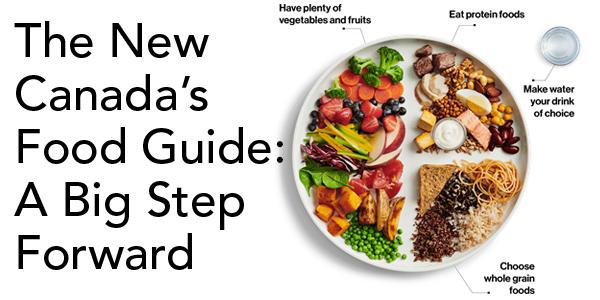
The new and revised Canada’s Food Guide (CFG) was officially released last Tuesday, January 22nd, 2019. This is the second component of Health Canada’s Healthy Eating Strategy that has been released following the trans-fat ban on September 17th, 2018. Beyond how long it took (11 years) to update, my overall impression of the new guide is that it is worthy of recognition and applause. Here’s why:
- It is based on current and credible scientific evidence to promote healthy eating. The new CFG is based on an extensive evidence review process that provided convincing findings on the relationship between food and health. The evidence strongly points to the health benefits of a diet higher in fruits and vegetables, whole grains, low-fat dairy, and lower consumption of red and processed meats, refined grains, and sugar-sweetened beverages. It also mentions to limit alcohol intake and follow low-risk drinking guidelines. In addition, the new CFG resembles that of the Brazilian Dietary Guidelines, which has received lots of positive feedback since its initial release in 2006, and last revision in 2014. (See the Brazilian Guideline).
- It is relevant to Canadians. Whereas the previous food guide set out criteria for portion sizes and servings only for a limited number of foods, the new CFG acknowledges that the Canadian population is multi-cultural and diverse. Therefore, a healthy diet can be achieved through a broader range of foods that are offered by different cultures. In addition, there is the promotion of cultural food practices in knowledge sharing and celebration. For example, indigenous communities may benefit from sharing and participating in their own traditional food practices such as hunting wild game, foraging and gathering from territorial lands.
- It acknowledges that food skills and literacy are important. Cooking and eating with family and friends, teaching your children how to prepare meals, and saving money by eating out less – do these sound familiar? The new CFG emphasizes that food skills and food literacy (which includes food skills along with nutrition knowledge, understanding the food environment, and self-confidence with food) are particularly useful tools to practically support healthy eating. Currently, Canadians spend about 30% of their food budget on meals and snacks purchased outside of the home, which is a result of the current food environment where highly processed products are readily available, cheap to purchase, offered in large portions, and heavily advertised. Developing appropriate food skills and literacy through cooking at home allows you to control what ingredients or foods you use. In addition, eating home cooked meals develops healthy eating behaviours such as mindful eating and fosters positive family relationships.
- It recognizes that there are barriers to healthy eating. For the first time, the CFG has paid mention to the fact that not all Canadians can easily access or have availability to healthy foods. Many of these factors (called social determinants of health) such as low income, can create barriers to healthy eating leading to food insecurity. Although the new CFG doesn’t directly address these issues, it highlights the need for a shared-responsibility model which encourages additional food policy initiatives to improve the food environment and reduce barriers to healthy eating. This should be collaboratively carried out by stakeholders at all levels and sectors of the food system (e.g. government, health professionals etc.). In addition, the new CFG recognizes that certain vulnerable population groups may require more support than others to reach healthy equity as a whole.
- It takes into account food and the environment. Another first for the food guide is considering what the impact of the food choices we make have on the environment. The new CFG promotes plant-based foods and proteins with lower animal-based products as a means to reduce environmental impact. These potential benefits include conserving soil, water and air. In addition, reducing food loss during production, processing and distribution as well as food waste from consumption can help reduce greenhouse gas emissions in Canada. Ensuring that Canadians have a more sustainable, longer term, abundant and reliable food supply may assist in promoting food security in the future.
With the new Canada’s Food Guide having only been recently released, there will be many eyes critically analyzing its messages. Personally, as a first step, I think it’s a significant improvement. However, I still anticipate additional resources and developments and would like to see the following more specific guidelines for certain priority populations (e.g. elderly, children and youth, indigenous population), and nutrition guidelines for institutions (e.g. hospitals, long term care homes, schools etc.)
Overall, the new Canada’s Food Guide does a much better job at attending to the general nutrition needs of the Canadian population. An important note is that the guide acknowledges that healthy eating is never a one-size-fits-all approach and that you may need to make individual adjustments to find what’s best for you. In that case, make sure to reach out to a Registered Dietitian for expert nutrition advice.
The next anticipated steps of the Healthy Eating Strategy is the release of the Front-Of-Package labelling symbol on packaged and processed foods and beverages high in saturated fat, sugar and sodium, and Bill S228 (Child Health Protection Act), an act to amend the Food and Drug Act (prohibiting food and beverage marketing directed at children). I hope to see these two initiatives provide the same level of evidence-base and consistency in messaging as the new Canada’s Food Guide for healthy eating.
So.... what do you think about the new Canada’s Food Guide? Share your thoughts in the comments below.
Access the new Canada’s Food Guide or the Healthy Eating Strategy

